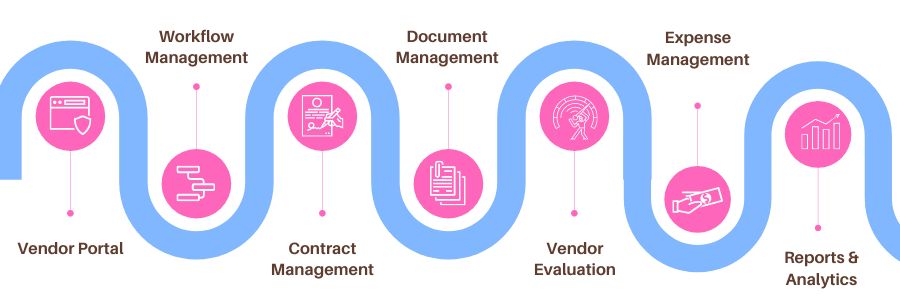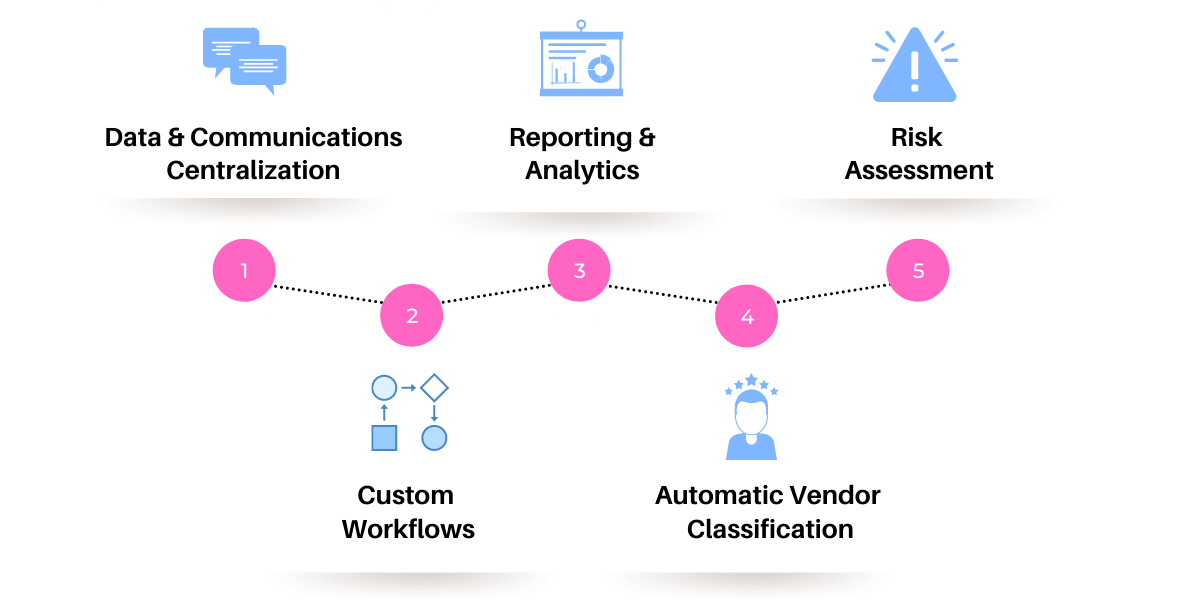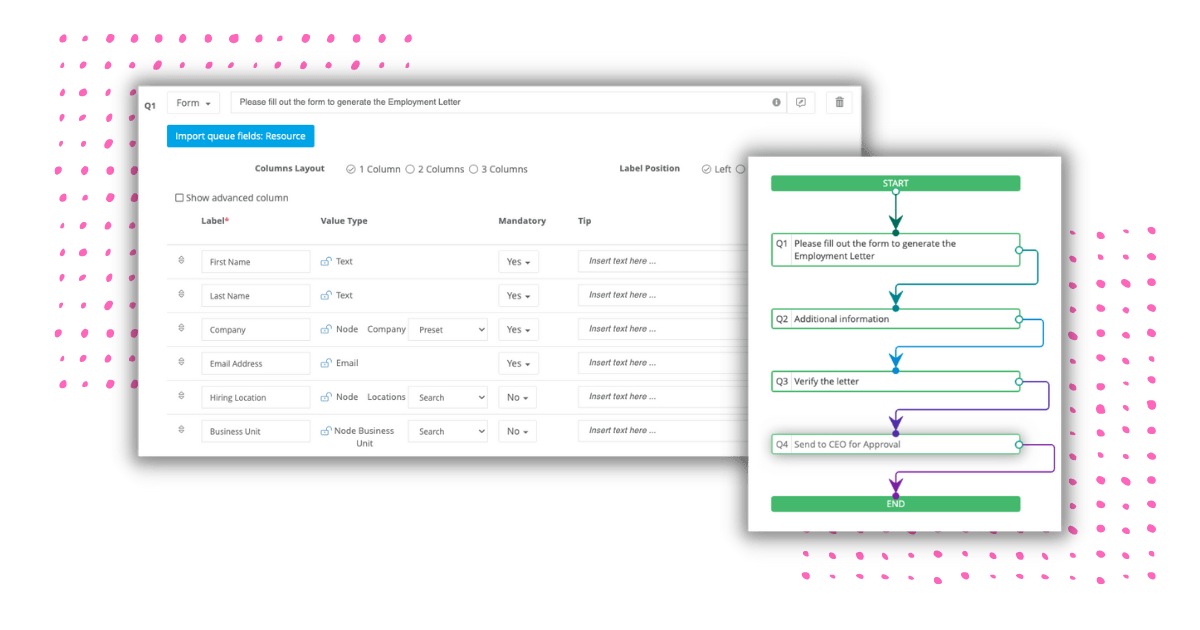“How to find the right solution for your organization”.
As a dynamic organization, you most likely work with a multitude of third party vendors. Or you may be outsourcing a great volume of work and services from external workforce as independent contractors.
This work can be a handful for hiring managers and vendor specialists.
BeyondTrust estimates that the average company has approximately 182 vendors.
So how can you accurately manage contingent workforce and key vendor relationships?
This is when Vendor Management Systems (VMS) come in.
What is a Vendor Management System?
Vendor Management Systems (VMS) are software solutions that help organizations to manage vendor related operations.
Tasks related to the procurement process, vendor onboarding process, purchase orders, due diligence, contracts, vendor performance, etc. As well as any other activity required for managing a vendor or supplier.
These are tools that help you streamline your vendor management tasks through automation and digital task management.
A vendor management platform should help you to:
-
-
- Establish goals
- Send out bids for vendors
- Select vendors
- Define the terms
- Monitor performance
- Manage contracts
- Spending Management
- Plan and forecast based on spending
-
Key functions of a VMS System

Benefits of adopting a Vendor Management System
-
-
- Centralized access to information and documents
- Standardization of vendor management processes
- Higher transparency into the process
- Centralized collaboration and communication
- Unique hub to manage contracts
-
Explore VF Vendor Management Tool!
Features to look for in a VMS System

1- Centralized data and communications
The procurement process can be very tedious and cumbersome.
Sometimes, depending on the type of product or service you are trying to obtain it may take even months.
A platform that offers centralized communications, collaboration and information management will allow teams to easily organize and follow each step.
While keeping all important documents and information in one place. As well as to make informed decisions with real time access to data.
2- Custom workflows
A VMS solution will help you to put in place digital standard processes which vendors can follow in autonomy each time.
But you need to make sure you can design your own processes. As opposed to following standard “one fits all kinds” of processes.
This is particularly important given that no organization follows processes exactly to others.
3- Reporting and analytics
This one does not require much explanation, as you will probably want to have an overall view of your operations.
It would be good to define which information you want to report on and which analytics are crucial. As not all VMS provide the same data.
Or better yet, look for solutions that are flexible and where you can customize your reporting. You never know what you will need tomorrow.
4- Automatic classification of vendors
Larger organizations often have trouble keeping track of the services each vendor has provided, and where the budget is at. This feature allows you to stay organized and automatically categorizes vendors and suppliers.
It will make it easier for department heads to have a clear view into all vendors and tasks.
5- Third party risk management assessment
Believe it or not, third party vulnerabilities do affect your company. So you will want to assess the risk of working with future vendors and your supplier performance overtime.
Make sure the solution you lean toward has an in-built risk assessment feature. Or that it lets you create your own.
Something worth mentioning
We’ve noticed many solutions currently available in the market call themselves Vendor Management Systems. However, many are partially or completely oriented to payment streamlining.
Make sure to look for solutions that do not only cover payments. Instead search for one with all vendor management tasks. Such as onboarding, contract and document management, information requests, purchase orders, etc.
How to know if you need a VMS software
Some criteria usually applies:
-
- You work with relatively few vendors but have limited personnel and engage in vendor management activities regularly
- You work with more than 25 vendors
- You are continuously onboarding new vendors
Vendor Management Software vs. Business Process Management: Which one to choose?
Before jumping into the differences between Vendor Management Systems and Business Process Management (BPM) platforms, it’s important to understand what BPM software is.
Every organization functions through a series of processes. Well, a BPM software is an application that helps to model, automate, execute, control, measure and optimize those business processes.
To go in-depth into BPM technology read this article.
Now, how can you know whether you need a VMS or a BPM? You need to determine what your needs are today and whether they’ll change in the future.
-
-
- If you’re looking to automate vendor and supplier management processes and tasks alone then a VMS should do the work.
- If you are looking to digitize operations beyond vendor management, you may want to explore BPM software. Also if you want to integrate vendor processes to other departments’ ones.
-
A BPM solution is the right fit for organizations looking to gain more visibility across teams and improve collaboration.
They also offer integrations that let you access data from other applications. This makes it easy to streamline operations across your entire organization.
Learn how to automate any business process in minutes!
5 Vendor Management Solutions to look for in 2023
If you’ve determined that a VMS is the right solution for you, you may want to look at one of these platforms.
1- Virtus Flow
It’s not the average Vendor Management solution. Instead it lets you build your own VMS following the rules and conditions you wish to add. It’s completely no code, which means you don’t need developers to put your VMS together.
Features include:
-
-
- Vendor portal (you can design and create your own vendor portal with the features that matter to you)
- Digital workflows (you can design complex rule based workflows in minutes)
- Dynamic Forms ( uses include: onboarding vendors, automating requests, forms, purchase orders, etc)
- Ticketing Management (particularly useful when support is needed, for example when working with service providers)
- Document Management (unique hub where to store, share and organize information)
- Reports (custom reports and analytics)
- On-premise or web based deployment
- Third party data driven integration (integrate with other solutions you currently use if needed)
-
2- Gatekeeper
As one of the most well-known VMS platforms, Gatekeeper serves as an all-in-one vendor lifecycle management platform. It offers automation, artificial intelligence, and vendor-facing features.
These are helpful to manage tasks like non disclosure agreements (NDAs) and information security reviews.
3- Ramp
This vendor management system helps you identify and collect all vendors and contract owners in one place. You can also choose to get notified when the next payment is due, and track how much you’ve ever spent with each vendor.
4- Precoro
Precoro promises to provide cost-effective and easy-to-use procurement solutions to help companies reduce administrative headaches, lower costs, and increase productivity. Precoro’s features include purchases requests, approval workflows, budget management, and inventory.
5- SAP Fieldglass
This cloud-based platform helps organizations find, manage, engage, and way third party vendors. It promises to help you with everything from cost to compliance management, security, quality of work, and more.





